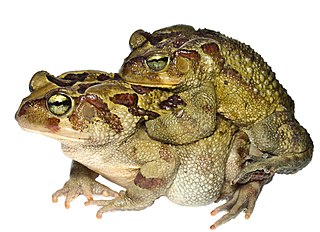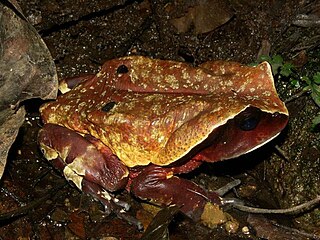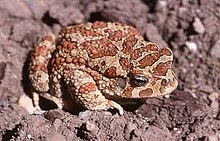Sclerophrys asmarae, also known as the Asmara toad, is a species of toad in the family Bufonidae. It is named after its type locality, the capital city of Eritrea, Asmara. It is found on the Ethiopian Highlands on both sides of the Rift Valley, with the western population extending north into Eritrea. Its natural habitats are montane grasslands, and tentatively at lower elevations, arid savanna. It is a locally common and adaptable species that is impacted by habitat degradation, though probably without posing a serious risk.
The Beira toad, or Beira pygmy toad, is a species of toad in the family Bufonidae from southern Africa.

Sclerophrys blanfordii is a species of toad in the family Bufonidae. It is found in northeastern Ethiopia, Somaliland, Djibouti, and Eritrea. The specific name blanfordii honours William Thomas Blandford, a British geologist and zoologist. Common names Blanford's toad and Ethiopia toad have been coined for it, the latter might specifically refer to the now-synonymized Bufo sibiliai.

Sclerophrys funerea is a species of toad in the family Bufonidae. It is found in west-central Africa, from Gabon, Republic of the Congo, and Angola eastward through the Democratic Republic of the Congo to Uganda, Rwanda, and Burundi. Its common names are Angola toad or somber toad.

Sclerophrys garmani, also known as Garman's toad or eastern olive toad, is a species of toad in the family Bufonidae. It is widely distributed in East and Southern Africa. However, populations north and south of Tanzania might represent distinct species. If so, the name Sclerophrys garmani would apply to populations from northeastern Africa. Furthermore, its southern boundary towards the range of Sclerophrys poweri in South Africa is also unclear.
Sclerophrys gracilipes is a species of toad in the family Bufonidae. It is found in southeastern Nigeria and east- and southward to southern Cameroon, Equatorial Guinea, Gabon, northern Republic of the Congo, and northern and northeastern Democratic Republic of the Congo. It is also likely to occur in southwestern Central African Republic and in the Cabinda Enclave of Angola. The holotype was collected from the Benito River in what was then French Congo. Common name French Congo toad has been coined for it.

The African common toad or guttural toad is a species of toad in the family Bufonidae. It is found in Angola, Botswana, Democratic Republic of the Congo, Ethiopia, Eswatini, Kenya, Lesotho, Malawi, Mauritius, Mozambique, Namibia, Réunion, Somalia, South Africa, Tanzania, Zambia, and Zimbabwe. Its natural habitats are subtropical or tropical dry forest, subtropical or tropical moist lowland forest, subtropical or tropical moist montane forest, dry savanna, moist savanna, temperate shrubland, subtropical or tropical dry shrubland, subtropical or tropical moist shrubland, subtropical or tropical dry lowland grassland, subtropical or tropical seasonally wet or flooded lowland grassland, subtropical or tropical high-altitude grassland, intermittent rivers, freshwater lakes, intermittent freshwater lakes, freshwater marshes, intermittent freshwater marshes, arable land, pastureland, rural gardens, urban areas, heavily degraded former forest, ponds, and canals and ditches.
The Nile Delta toad or Damietta toad is a species of toad in the family Bufonidae. It is endemic to Egypt, where it is found from the Nile Delta to as far south as Luxor. Its natural habitats are swamps, freshwater marshes, arable land, urban areas, seasonally flooded agricultural land and canals and ditches.

Sclerophrys maculata — commonly known as Hallowell's toad, the flat-backed toad, and the striped toad — is an African member of Bufonidae, the true toad family.

The western leopard toad is a species of toad in the family Bufonidae. The species is endemic to the low-lying areas of the Cape Peninsula, the Cape Flats and the Agulhas flats of the Western Cape, South Africa.

The eastern leopard toad is a species of toad in the family Bufonidae. It is endemic to South Africa. Its natural habitats are temperate shrubland, subtropical or tropical dry shrubland, subtropical or tropical dry lowland grassland, rural gardens, and urban areas. It is threatened by habitat loss.
Sclerophrys pentoni is a species of toad in the family Bufonidae found in western and central Africa. Its natural habitats are dry savanna, subtropical or tropical dry shrubland, subtropical or tropical dry lowland grassland, rivers, intermittent freshwater marshes, and hot deserts. It is threatened by habitat loss.

The raucous toad, also known as Ranger's toad, is a species of toad from Southern Africa.

Sclerophrys regularis, commonly known as the African common toad, square-marked toad, African toad, Egyptian toad, African bouncing toad and Reuss's toad, is a species of toad in the family Bufonidae. It is found widely in the Subsaharan Africa, with its range extending to the oases in Algeria and Libya as well as to northern Nilotic Egypt. Specifically, it is found in Angola, Benin, Burkina Faso, Cameroon, Cape Verde, Central African Republic, Chad, Republic of the Congo, Democratic Republic of the Congo, Ivory Coast, Egypt, Ethiopia, Gabon, Ghana, Guinea, Guinea-Bissau, Kenya, Liberia, Mali, Niger, Nigeria, Rwanda, Senegal, Sierra Leone, Sudan, and Uganda.
Sclerophrys steindachneri is a species of toad in the family Bufonidae. It is found in Cameroon, Central African Republic, Chad, Democratic Republic of the Congo, Ethiopia, Kenya, Nigeria, Somalia, Sudan, Tanzania, and Uganda. Its natural habitats are subtropical or tropical moist lowland forests, moist savanna, subtropical or tropical moist shrubland, subtropical or tropical seasonally wet or flooded lowland grassland, swamps, freshwater marshes, intermittent freshwater marshes, plantations, rural gardens, urban areas, ponds, and canals and ditches. It is threatened by habitat loss.

The African giant toad, Congo toad, or Cameroon toad is a species of toad in the family Bufonidae. It is found in Cameroon, Central African Republic, Republic of the Congo, Democratic Republic of the Congo, Ivory Coast, Equatorial Guinea, Gabon, Ghana, Nigeria, possibly Liberia, and possibly Sierra Leone. The toad's natural habitats are subtropical or tropical moist lowland forests, freshwater marshes, intermittent freshwater marshes, plantations, and heavily degraded former forest. While it is a "least concern" species, it is threatened by habitat loss.
The subdesert toad is a species of toad in the family Bufonidae. It is found in Algeria, Cameroon, Chad, Djibouti, Eritrea, Ethiopia, Gambia, Guinea, Kenya, Libya, Mali, Mauritania, Niger, Senegal, Somalia, Sudan, Tanzania, Uganda, Western Sahara, possibly Angola, possibly Benin, possibly Burkina Faso, possibly Central African Republic, possibly Democratic Republic of the Congo, possibly Guinea-Bissau, and possibly Nigeria. Its natural habitats are dry savanna, subtropical or tropical dry shrubland, subtropical or tropical dry lowland grassland, intermittent rivers, intermittent freshwater marshes, freshwater springs, hot deserts, and arable land. Its conservation status is assessed by the International Union for Conservation of Nature as being of "least concern".

The African red toad, or African split-skin toad, is a species of toad in the family Bufonidae. It is the only species of the monotypic genus Schismaderma. It is found in Angola, Botswana, Democratic Republic of the Congo, Eswatini, Kenya, Malawi, Mozambique, Namibia, South Africa, Tanzania, Zambia, Zimbabwe, and possibly Lesotho. Its natural habitats are dry savanna, moist savanna, subtropical or tropical dry shrubland, subtropical or tropical moist shrubland, subtropical or tropical dry lowland grassland, freshwater marshes, intermittent freshwater marshes, arable land, pastureland, urban areas, water storage areas, ponds, canals and ditches, and man-made karsts.

Sclerophrys is a genus of "true toads", family Bufonidae, native to Africa and the southern Arabian Peninsula. Originally, all of these species were classified in the genus Bufo. The genus, originally named Amietophrynus, was split due to large enough taxonomic divergence. Ohler and Dubois showed in 2016 that Sclerophrys capensis Tschudi, 1838 is the same species as Bufo regularis rangeri Hewitt, 1935, the type species of Amietophrynus. Because the former name is older, the implication is that Amietophrynus is a junior synonym of Sclerophrys.

Poyntonophrynus, also known as pygmy toads, are a genus consisting of ten true toad species native to Sub-Saharan Africa. Originally, all Poyntonophrynus species were included in the genus Bufo. The genus was split due to large enough taxonomic divergence as evidenced by molecular markers. The genus is named in honour of John C. Poynton, South African herpetologist, with phrynus being Greek for toad.













